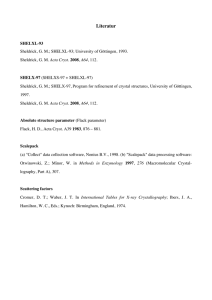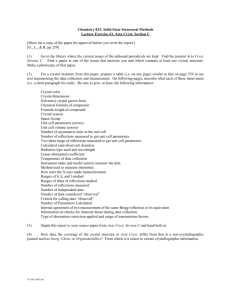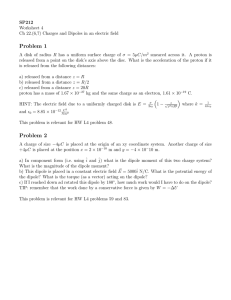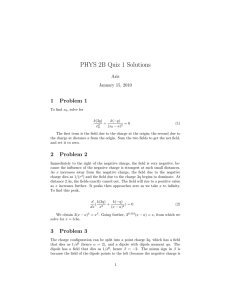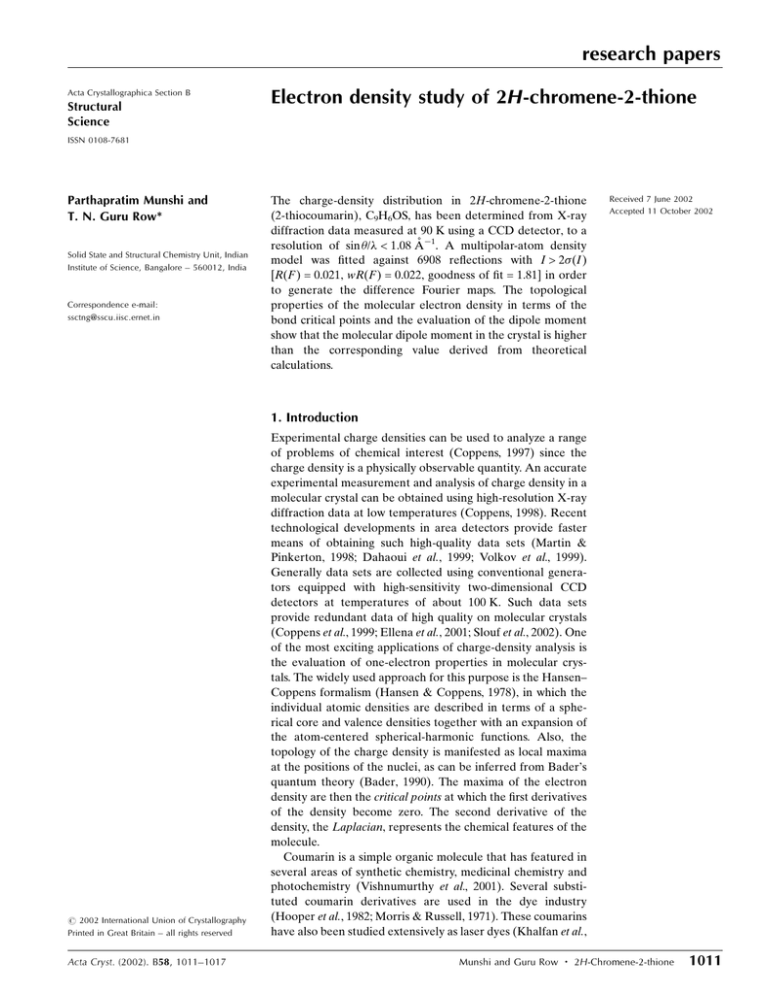
research papers
Acta Crystallographica Section B
Structural
Science
Electron density study of 2H-chromene-2-thione
ISSN 0108-7681
Parthapratim Munshi and
T. N. Guru Row*
Solid State and Structural Chemistry Unit, Indian
Institute of Science, Bangalore ± 560012, India
Correspondence e-mail:
ssctng@sscu.iisc.ernet.in
The charge-density distribution in 2H-chromene-2-thione
(2-thiocoumarin), C9H6OS, has been determined from X-ray
diffraction data measured at 90 K using a CCD detector, to a
Ê ÿ1. A multipolar-atom density
resolution of sin / < 1.08 A
model was ®tted against 6908 re¯ections with I > 2(I )
[R(F ) = 0.021, wR(F) = 0.022, goodness of ®t = 1.81] in order
to generate the difference Fourier maps. The topological
properties of the molecular electron density in terms of the
bond critical points and the evaluation of the dipole moment
show that the molecular dipole moment in the crystal is higher
than the corresponding value derived from theoretical
calculations.
Received 7 June 2002
Accepted 11 October 2002
1. Introduction
# 2002 International Union of Crystallography
Printed in Great Britain ± all rights reserved
Acta Cryst. (2002). B58, 1011±1017
Experimental charge densities can be used to analyze a range
of problems of chemical interest (Coppens, 1997) since the
charge density is a physically observable quantity. An accurate
experimental measurement and analysis of charge density in a
molecular crystal can be obtained using high-resolution X-ray
diffraction data at low temperatures (Coppens, 1998). Recent
technological developments in area detectors provide faster
means of obtaining such high-quality data sets (Martin &
Pinkerton, 1998; Dahaoui et al., 1999; Volkov et al., 1999).
Generally data sets are collected using conventional generators equipped with high-sensitivity two-dimensional CCD
detectors at temperatures of about 100 K. Such data sets
provide redundant data of high quality on molecular crystals
(Coppens et al., 1999; Ellena et al., 2001; Slouf et al., 2002). One
of the most exciting applications of charge-density analysis is
the evaluation of one-electron properties in molecular crystals. The widely used approach for this purpose is the Hansen±
Coppens formalism (Hansen & Coppens, 1978), in which the
individual atomic densities are described in terms of a spherical core and valence densities together with an expansion of
the atom-centered spherical-harmonic functions. Also, the
topology of the charge density is manifested as local maxima
at the positions of the nuclei, as can be inferred from Bader's
quantum theory (Bader, 1990). The maxima of the electron
density are then the critical points at which the ®rst derivatives
of the density become zero. The second derivative of the
density, the Laplacian, represents the chemical features of the
molecule.
Coumarin is a simple organic molecule that has featured in
several areas of synthetic chemistry, medicinal chemistry and
photochemistry (Vishnumurthy et al., 2001). Several substituted coumarin derivatives are used in the dye industry
(Hooper et al., 1982; Morris & Russell, 1971). These coumarins
have also been studied extensively as laser dyes (Khalfan et al.,
Munshi and Guru Row
2H-Chromene-2-thione
1011
research papers
1987) and have shown state-dependent variation in the static
dipole moment. Coumarins have been employed as probes for
the examination of ultrafast solvation effects (Maroncelli &
Fleming, 1987). Theoretical calculations using semi-empirical
methods demonstrate that coumarin and its sulfur derivatives
possess well de®ned dipole moments. In addition, the sulfur
derivatives of coumarin crystallize in non-centrosymmetric
space groups (Munshi & Guru Row, 2001, 2002). These
features are responsible for coumarin and its derivatives to
exhibit second-harmonic generation (SHG) effects. We have
studied the geometry and the molecular-packing patterns of
several coumarins and its derivatives (Vishnumurthy et al.,
2001) in order to evaluate the features of non-covalent interactions. In an effort to generate materials that possess a larger
dipole moment than coumarin, we have recently synthesized
and studied the structures of the sulfur derivatives (Munshi &
Guru Row, 2001, 2002). An accurate high-resolution chargedensity study followed by a topological analysis will provide
insights into the factors responsible for the large static dipole
moment. The value of the dipole moment can be determined
from the multipole model ®tted to the experimental X-ray
diffraction data. The value thus obtained can be compared
with the theoretical value determined either based on the
density functional theory (DFT) or the Hartree±Fock (HF)
approach using the GAUSSIAN98 package (Frisch et al.,
2002).
Charge-density studies involving S atoms are rare in the
literature. To our knowledge, the charge-density distribution
has been analyzed for only ®ve molecules that contain sulfur
(Bats & Coppens, 1977; Weber & Craven, 1987; Fabius et al.,
1989; Scherer et al., 2000), and the nature of the multipolar
expansion around sulfur is not fully understood. This study
will be the ®rst example of a C S case, and the evaluation of
the charge-density parameters will be of interest. This paper
presents the charge-density distribution and the topological
properties of 2H-chromene-2-thione (2-thiocoumarin).
2. Experimental
The crystal structure of 2-thiocoumarin has been reported
earlier at room temperature (Munshi & Guru Row, 2001).
Preliminary theoretical estimates of the dipole moment, which
were made using GAUSSIAN98 and which were based on the
coordinates obtained from the above experiment, suggested
that the molecular dipole moment is about 6.5 Debye.
A slow-evaporation method at low temperature was used to
recrystallize the compound from chloroform and hexane (1:4),
in order to generate crystals of better quality for the chargedensity study. A good-quality crystal (0.60 0.37 0.10 mm)
was selected for the X-ray diffraction study and was mounted
in a Lindemann capillary at room temperature. The sample
1012
Munshi and Guru Row
2H-Chromene-2-thione
Table 1
A summary of the 90 K X-ray data collection strategy.
Run
Frame
2 ( )
! ( )
' ( )
( )
Axis
Width
( )
No. of
frames
Time
(s)
1
2
3
4
5
6
7
8
9
10
11
12
001
001
001
001
001
001
001
001
001
001
001
001
ÿ25
ÿ25
ÿ25
ÿ25
ÿ50
ÿ50
ÿ50
ÿ50
ÿ75
ÿ75
ÿ75
ÿ75
ÿ25
ÿ25
ÿ25
ÿ25
ÿ50
ÿ50
ÿ50
ÿ50
ÿ75
ÿ75
ÿ75
ÿ75
0
90
180
270
0
90
180
270
0
90
180
270
54.79
54.79
54.79
54.79
54.79
54.79
54.79
54.79
54.79
54.79
54.79
54.79
2
2
2
2
2
2
2
2
2
2
2
2
0.3
0.3
0.3
0.3
0.3
0.3
0.3
0.3
0.3
0.3
0.3
0.3
606
606
606
606
606
606
606
606
606
606
606
606
15
15
15
15
30
30
30
30
45
45
45
45
was cooled to 90 K (ramp rate 120 K hÿ1) with an Oxford
Cryostream N2 open-¯ow cryostat. The crystal was allowed to
stabilize at 90 K for 1 h, and the unit-cell parameters were
determined every 15 min thereafter until the estimated standard deviations in cell dimensions did not vary beyond
acceptable limits. Three batches of data were collected as
follows: the ®rst covered the whole sphere of reciprocal space
up to 55 in 2; the second higher-order batch covered up to
77 in 2; and the ®nal high order covered up to 100 in 2.
For each data set, 2424 frames were collected with a scan width
of 0.3 in ! and an exposure time of 15 s, 30 s and 45 s per
frame, respectively. The details of the data-collection strategy
are summarized in Table 1. The entire data set, which
consisted of 7272 frames, was collected over a period of 80 h
and was monitored with the SMART software package
(Bruker, 1998). The frames were then integrated with SAINT
(Bruker, 1998) using a narrow-frame integration method. A
total of 9651 re¯ections were used for the determination of the
unit-cell parameters. Of the 37 982 re¯ections obtained from
SAINT, 37 879 were accepted for sorting, averaging and
scaling by the program SORTAV (Blessing, 1987). Of the
37 879 integrated re¯ections, 2053 were rejected as outliers and
35 826 were accepted. 642 re¯ections were measured only
once, 1543 were measured twice and 5423 were measured
three or more times. After merging the data, a total of 7608
Ê ÿ1
unique re¯ections to a resolution of sin/ < 1.08 A
Ê
(Dmin = 0.46 A) were recovered with an overall completeness
of 99.2%. All 35 826 intensities were corrected for decay, beam
inhomogeneity and absorption effects (Tmin = 0.808,
Tmax = 0.964). The internal agreement factor for the ®nal data
set is Rint = 0.038. No problems from the /2 contamination
appeared in the entire data set.
3. Structure refinement
The structure was solved by direct methods using SHELXS97
and re®ned in the spherical-atom approximation using
SHELXL97 (Sheldrick, 1997). Fig. 1 gives the ORTEP
(Farrugia, 1997) diagram together with the numbering of the
atoms. All H atoms were located by the difference-Fourier
method and were re®ned isotropically; other non-H atoms
Acta Cryst. (2002). B58, 1011±1017
research papers
were re®ned anisotropically. The re®nements were based on
F 2 and were performed using all 7608 re¯ections, which
converged at R(F) = 0.033, wR(F ) = 0.088 and goodness of
®t = 1.036. Fig. 2 shows the packing of the molecules in the
crystal lattice viewed along the b axis. The molecules pack in
an antiparallel fashion that generates an overall herringbonelike structure, and the interactions are stabilized mainly by van
der Waals interactions. The aspherical-atom re®nement was
based on F and was carried out, using the XD package
(Koritsanszky et al., 1999), on 6908 re¯ections with I > 2(I ).
The XD package consists of a least-squares re®nement
program based on the Hansen±Coppens multipole formalism
(Hansen & Coppens, 1978). Initially only the scale factor was
re®ned on all data, in order to check the accuracy of the
data transfer from SHELX to XD via XDINI. The real
and imaginary dispersion corrections to the form factors
(International Tables for Crystallography, 1992, Vol. C, pp.
206±222) were used in all the structure-factor calculations.
Next, the higher-order re®nement was performed using 3838
Ê ÿ1 and I > 2(I ). This
re¯ections with 0.8 < sin / < 1.08 A
re®nement resulted in accurate positional coordinates and
thermal parameters for all non-H atoms. The values of the
maximum differences of the mean square displacement
amplitudes (DMSDA) (Hirshfeld, 1976) indicate the inadequacies in the model at convergence. These values should be
Ê 2 for bonds between carbon-like atoms for
less than 0.001 A
correct models. In the current experiment the value of
DMSDA at the convergence of the re®nement [R(F) = 0.029,
wR(F) = 0.032, where w = 1/ 2(F 2) and goodness of ®t = 1.22]
has a maximum value for the C1ÐS1 bond (Z2 =
Ê 2) suggesting that the model is adequate. The
6 10ÿ4 A
positional and isotropic thermal parameters of the H atoms
were then re®ned using the lower-angle data (0.057 < sin /
Ê ÿ1). Further multipolar re®nement was carried out in
< 0.8 A
the following manner using all 6908 re¯ections with I > 2(I ).
Initially the scale factor and monopole populations for all
atoms were re®ned, and then a single re®nement was
performed. However, the positions of the H atoms in this
re®nement, as well as in the subsequent re®nements, were
Figure 1
ORTEP diagram of the molecule showing the numbering scheme used in
this work. Thermal ellipsoids are drawn at the 50% probability level.
Acta Cryst. (2002). B58, 1011±1017
®xed using the reset bond option, which constrains the H
atoms to average bond-distance values that are determined
from neutron-diffraction studies (Allen, 1986). Re®nements
that released dipole, quadrupole, octapole and hexadecapole
(hexadecapole only for S and O atoms) populations with a
single value were performed in a stepwise manner. At each
step the re®nements were cycled until convergence. Finally a
single 0 was re®ned for each species for all non-H atoms along
with the rest of the parameters. No extinction correction was
applied during the re®nements. Tests on isotropic type1 and
type2 corrections did not signi®cantly change the quality of the
residual maps. The maximum DMSDA value is Z2 =
Ê 2 for the C8ÐC7 bond. The good quality of the
5 10ÿ4 A
®nal model is also indicated by Fig. 3, which maps the residual
density in the molecular plane as obtained in the ®nal cycle of
the re®nement. Table 2 lists relevant experimental details.
4. Results and discussion
Atomic coordinates, equivalent isotropic displacement parameters, anisotropic thermal parameters, bond lengths, angles,
Figure 2
Molecular packing of the crystal viewed along the b axis.
Munshi and Guru Row
2H-Chromene-2-thione
1013
research papers
Table 2
Experimental details.
Crystal data
Chemical formula
Chemical formula weight
Cell setting, space group
Ê)
a, b, c (A
Ê 3)
V (A
Z
Dx (Mg mÿ3 )
Radiation type
No. of re¯ections for cell parameters
range ( )
(mmÿ1 )
Temperature (K)
Crystal form, color
Crystal size (mm)
C9 H6 OS
162.21
Orthorhombic, P 21 21 21
4.0515 (2), 10.1749 (7), 17.6519 (9)
727.67 (7)
4
1.481
Mo K
9651
2.31±50.08
0.369
90.0 (2)
Prism, yellow
0.60 0.37 0.10
Data collection
Diffractometer
CCD area detector Bruker AXS
SMART APEX
' and ! scans
Empirical
0.8088
0.9640
37982, 7608, 6908
Data collection method
Absorption correction
Tmin
Tmax
No. of measured, independent and
observed re¯ections
Criterion for observed re¯ections
Rint
max ( )
Range of h, k, l
I > 2
I
0.038
50.11
0!h!8
0 ! k ! 21
ÿ37 ! l ! 37
None
Extinction correction
Re®nement
Re®nement on
R, wR, S
No. of re¯ections and parameters
used in re®nement
H-atom treatment
Weighting scheme
=max
Ê ÿ3 )
max , min (e A
Flack parameter
F
0.0217, 0.0223, 1.8112
6908, 318
No re®nement
w = 1/[ 2 (F 2o )]
0.002
0.199, ÿ0.276
ÿ0.01 (3)
Computer programs used: Bruker SMART, Bruker SAINT (Bruker, 1998), SHELXS97
(Sheldrick, 1997), XD (Koritsanszky et al., 1999).
dihedral angles and the charge density parameters Pv and Plm
have been deposited as supplementary material.1 The molecules in the crystal lattice are held together only via van der
Waals interactions.
The residual density map (Fig. 3) is reasonably clear of
noise, and therefore the high quality of the data is con®rmed.
It can be seen that there is an accumulation of residual charge
density in the vicinity of the S atom, which could be due to the
possible nature of polarization and also due to the de®ciencies
in the multipole model to account for the overall density at
this site. The experimental dynamic-deformation density map,
which is given in Fig. 4(a), is calculated using 3955 re¯ections
Ê ÿ1 and I > 2(I ). The correper octant with sin/ < 1.08 A
sponding static-deformation density map, which is calculated
based on the difference between the atom-centered multipole
1
Supplementary data for this paper are available from the IUCr electronic
archives (Reference: LC0053). Services for accessing these data are described
at the back of the journal.
1014
Munshi and Guru Row
2H-Chromene-2-thione
Figure 3
Residual density map in the molecular plane. The ®rst positive contour is
Ê ÿ3 and the contour levels are at 0.1 e A
Ê ÿ3 intervals. The
at 0.05 e A
Ê ÿ3 and the contour levels are at
negative contours start at ÿ0.05 e A
Ê ÿ3 intervals. The solid lines are positive contours and the broken
ÿ0.1 e A
lines are negative contours.
density and the charge distribution of the pro-molecule
density, is given in Fig. 4(b). The lone pairs on the S and the O
atoms are clearly visible in both these maps.
In an effort to make a quantitative analysis of these
observations, the nature of the bonding features was investigated. For every chemical bond in the structure there is a point
at which the ®rst derivative of the charge density vanishes
(Bader, 1990). There are three non-zero principle curvatures ±
two with negative values and one with a positive value ± in the
bonding density, b, at this bond critical point (BCP). Such a
BCP is labeled (3, ÿ1): 3 for the number of non-zero curvatures and ÿ1 for the algebraic sum of the curvature signs. The
(3, ÿ1) BCPs of the charge density were evaluated, and Fig. 5
shows the BCPs in the molecule along with the paths that link
the atoms, which are referred to as the bond paths. Table 3 lists
the bonding between atoms; the value of the charge density,
b(r); the Laplacian, r2b(r); D1 and D2, the distances to the
BCP from the ®rst and second atom, respectively; the eigenvalues of the Hessian matrix; and the bond ellipticity, ". The
values of these quantities in our analysis of the aromatic
portion of the structure are similar to those generally found in
aromatic moieties (Ellena et al., 2001). The double-bond
nature of the C S bond is clearly indicated by its " value
(0.26) and by the nearly equal values of D1 and D2 for this
bond. The critical points on the C1ÐO1 and C8ÐO1 bonds
are shifted from the bond midpoints; their " values are 0.11
and 0.12, respectively, which suggest a high degree of polarization in these bonds. The value of r2b(r) on the C S bond
is signi®cantly large (ÿ3.264), and the corresponding bonding
density, b, is signi®cantly low (1.558). These values indicate
that the charge density is drawn out into the lone-pair region
of the S atom. These features will certainly in¯uence the oneActa Cryst. (2002). B58, 1011±1017
research papers
electron properties and hence will have a bearing on the
calculated dipole moment components. Fig. 6 shows the
experimental Laplacian r2b(r), which clearly shows the
features of all the intramolecular interactions. At the end of
the re®nement the Pv value of the S atom is 5.29 (4) while that
of the O atom is 6.28 (4), and these values depict the nature of
the charge distribution in the valence shell in this molecule.
The re®ned -parameters show a contraction of the S atom
( = 1.16) while the O atom remains intact ( = 1.00).
However, all C atoms show a slight contraction ( = 1.03). The
corresponding 0 values are 0.85 for S, 0.96 for O and 0.88 for
C atoms.
Table 3
Intramolecular bond critical points and their properties.
Bond
b(r) r2b(r)
D1
D2
1
2
3
"
S(1)ÐC(1)
O(1)ÐC(8)
O(1)ÐC(1)
C(8)ÐC(9)
C(8)ÐC(7)
C(3)ÐC(9)
C(3)ÐC(2)
C(9)ÐC(4)
C(2)ÐC(1)
C(4)ÐC(5)
C(7)ÐC(6)
C(6)ÐC(5)
1.558
2.112
1.995
2.150
2.198
2.020
2.490
2.213
1.954
2.150
2.324
2.073
0.8215
0.8193
0.8504
0.7335
0.7336
0.7060
0.7191
0.7231
0.6852
0.7019
0.6862
0.7031
0.8340
0.5574
0.5137
0.6652
0.6615
0.7288
0.6402
0.6882
0.7507
0.6844
0.7056
0.7024
ÿ10.16
ÿ18.58
ÿ17.13
ÿ17.82
ÿ17.41
ÿ15.31
ÿ20.28
ÿ17.14
ÿ14.86
ÿ17.07
ÿ17.36
ÿ15.59
ÿ8.06
ÿ16.55
ÿ15.43
ÿ13.63
ÿ13.99
ÿ12.70
ÿ16.36
ÿ14.14
ÿ12.37
ÿ13.63
ÿ13.83
ÿ12.78
14.95
15.90
14.13
11.00
11.32
12.45
10.94
12.02
11.54
11.57
13.29
12.55
0.26
0.12
0.11
0.31
0.24
0.21
0.24
0.21
0.20
0.25
0.26
0.22
ÿ3.264
ÿ19.235
ÿ18.421
ÿ20.449
ÿ20.085
ÿ15.567
ÿ25.702
ÿ19.265
ÿ15.685
ÿ19.134
ÿ17.907
ÿ15.821
Since our main aim is to obtain an accurate molecular
dipole moment, the program XDPROP from the XD package
is employed to obtain the components of the dipole moment.
Table 4 gives the values of the components and the value of
the net dipole moment that are obtained from the experiment.
Table 4 also provides the values for the dipole moments as
obtained from theoretical calculations based on the package
GAUSSIAN98. The calculations have been performed using
both HF and DFT methods. The DFT method (basis set
6-311G**) produces a dipole moment that is signi®cantly
smaller than that obtained using the ab initio HF method at
the same level. The molecular geometry as found in the ®nal
re®nement has been adopted in all the calculations. In the
charge-density analysis of a polar molecule, 2-methyl-4nitroaniline (Howard et al., 1992), it is observed that the
experimentally determined value of the dipole moment is
rather high compared with the theoretically determined value.
A similar feature is also observed in the structure of 2-thiocoumarin. The main contributors to the dipole-moment
components are the S and the O atoms in this structure. The
coordinates and the population parameters of the valence
shell Pv, and their corresponding values of P11+, P10, P11ÿ and
Figure 4
(a) Dynamic-deformation density map in the plane of the molecule. The
Ê ÿ3 and the contour levels are at
®rst positive contour is at 0.05 e A
Ê ÿ3 intervals. The ®rst negative contour is at ÿ0.05 e A
Ê ÿ3 and the
0.1 e A
ÿ3
Ê
contour levels are at ÿ0.1 e A intervals. The solid lines are positive
contours and the broken lines are negative contours. (b) Staticdeformation density map in the plane of the molecule. The positive
Ê ÿ3 intervals and the negative contour levels
contour levels are at 0.1 e A
Ê ÿ3 intervals. The solid lines are positive contours and the
are at ÿ0.1 e A
broken lines are negative contours.
Acta Cryst. (2002). B58, 1011±1017
Figure 5
Bond-path character in the molecule showing the critical-point locations
along the bonds.
Munshi and Guru Row
2H-Chromene-2-thione
1015
research papers
5. Conclusion
Table 4
Molecular dipole moment of 2-thiocoumarin².
X-ray diffraction
HF/6-21G**
HF/6-31G**
HF/6-311G**
B3LYP/6-311G**
x
y
z
||
15.2
5.9
6.0
5.9
5.2
1.1
2.4
2.6
2.6
2.3
0.4
0.0
0.0
0.0
0.0
15.2
6.4
6.6
6.5
5.7
² All values in Debyes.
, form the basis of the evaluation of the dipole moment.
Since, in the compound under study, the in¯uence of the
polarization of the charge density is dominant at these atomic
sites, the resulting dipole-moment values differ substantially
from theoretical values. It must be noted that the coordinates
in both theory and experimental calculations refer to the same
orientation of the molecule. As discussed earlier the values of
" and D1 and D2 in the bonds associated with the O atom and
the rather large value of r2b(r) in the C S region appear
to contribute to the large value of the dipole moment
(15.2 Debye). Recently, a careful evaluation of molecular
dipole moments from the multipole re®nement of X-ray
diffraction data (Abramov et al., 1999; Arnold et al., 2000) has
shown the in¯uence of the crystal lattice on the enhancement
of molecular dipole moments. The limitations in theory
(Bader, 1990) to de®ne the topology of the molecular
boundary could also in¯uence the differences seen in theory
and experiment. Experimental charge-density analyses of yet
another sulfur-containing coumarin, 2H-thiochromen-2-one,
and of coumarin itself are currently being investigated by us in
order to obtain better insights into the dipole-moment behavior in this class of compounds.
Figure 6
Laplacian [r2b(r)] distribution in the plane of the molecule. Contours
Ê ÿ5. The solid lines are
are drawn at logarithmic intervals in ÿr2b e A
positive contours and the broken lines are negative contours.
1016
Munshi and Guru Row
2H-Chromene-2-thione
The multipolar model based on the electron density of
2-thiocoumarin con®rms the presence of a large molecular
dipole moment and suggests the possibility of generating a
new series of SHG materials. Topological analysis reveals the
nature of the charge distribution and bonding features in this
molecule. The experimental values for the dipole moment are
high compared with the theoretical values, which suggests
possible inadequacies in the multipolar expansion for highly
polarized molecular crystals.
We thank the Department of Science and Technology, India
for data collection on the CCD facility setup under the IRFADST program.
References
Abramov, Y., Volkov, A. & Coppens, P. (1999). Chem. Phys. Lett. 311,
81±86.
Allen, F. H. (1986). Acta Cryst. B42, 515±522.
Arnold, W. D., Sanders, L. K., McMahon, M. T., Volkov, A. V., Wu, G.,
Coppens, P., Wilson, S. R., Godbout, N. & Old®eld, E. (2000). J.
Am. Chem. Soc. 122, 4708±4717.
Bader, R. F. W. (1990). Atoms in Molecules ± A Quantum Theory.
Oxford: Clarendon.
Bats, J. W. & Coppens, P. (1977). Acta Cryst. B33, 37±45; 1542±1548.
Blessing, R. H. (1987). Crystallogr. Rev. 1, 3±58.
Bruker (1998). SMART. SAINT. Bruker AXS Inc., Madison,
Wisconsin, USA.
Coppens, P. (1997). X-ray Charge Densities and Chemical Bonding.
New York: Oxford University Press.
Coppens, P. (1998). Acta Cryst. A54, 779±788.
Coppens, P., Abramov, Y., Carducci, M., Korjov, B., Novozhilova, I.,
Alhmbra, C. & Pressprich, M. R. (1999). J. Am. Chem. Soc. 121,
2585±2593.
Dahaoui, S., Jelsch, C., Howard, J. A. K. & Lecomte, C. (1999). Acta
Cryst. B55, 226±230.
Ellena, J., Goeta, A. E., Howard, J. A. K. & Punte, G. (2001). J. Phys.
Chem. A105, 8696±8708.
Fabius, B., Cohen-addad, C., Larsen, F. K., Lehmann, M. S. & Becker,
P. (1989). J. Am. Chem. Soc. 111, 5728±5732.
Farrugia, L. J. (1997). J. Appl. Cryst. 30, 565.
Frisch, M. J., Trucks, G. W., Sehlegel, H. B., Scuseria, G. E., Robb,
M. A., Cheeseman, J. R., Zakrzewski, V. G., Montgomery, J. A. Jr,
Stratmann, R. E., Burant, J. C., Dapprich, S., Millam, J. M., Daniels,
A. D., Kudin, K. N., Strain, M. C., Farkas, O., Tomasi, J., Barone, V.,
Cossi, M., Cammi, R., Mennucci, B., Pomelli, C., Adamo, C.,
Clifford, S., Ochterski, J., Petersson, G. A., Ayala, P. Y., Cui, Q.,
Morokuma, K., Rega, N., Salvador, P., Dannenberg, J. J., Malick,
D. K., Rabuck, A. D., Raghavaehari, K., Foresman, J. B.,
Cioslowski, J., Ortiz, J. V., Baboul, A. G., Stefanov, B. B., Liu, G.,
Liashenko, A., Piskorz, P., Komaromi, I., Gomperts, R., Martin,
R. L., Fox, D. J., Keith, T., Al-Laham, M. A., Peng, C. Y.,
Nanayakkara, A., Challacombe, M., Gill, P. M. W., Johnson, B.,
Chen, W., Wong, M. W., Andres, J. L., Gonzalez, C., Head-Gordon,
M., Replogle, E. S. & Pople, J. A. (2002). GAUSSIAN98. Revision
A.11.3. Gaussian, Inc., Pittsburgh, PA, USA.
Hansen, N. K. & Coppens, P. (1978). Acta Cryst. A34, 909±921.
Hirshfeld, F. L. (1976). Acta Cryst. A32, 239±244.
Acta Cryst. (2002). B58, 1011±1017
research papers
Hooper, D. C., Wolfson, J. S., McHugh, G. L., Winters, M. B. & Swartz,
M. N. (1982). Antimicrob. Agents Chemother. 22, 662±671.
Howard, S. T., Hursthouse, M. B., Lehmann, C. W., Mallinson, P. R. &
Frampton, C. S. (1992). J. Chem. Phys. 97, 5616±5630.
Khalfan, H., Abuknesha, R., Rond-Weaver, M., Price, R. G. &
Robinson, R. (1987). Chem. Abstr. 106, 63932.
Koritsanszky, T., Howard, S., Su, Z., Mallinson, P. R., Richter, T. &
Hansen, N. K. (1999). XD. Computer Program Package for
Multipole Re®nement and Analysis of Electron Densities from
Diffraction Data. Free University of Berlin, Germany.
Maroncelli, M. & Fleming, G. R. (1987). J. Chem. Phys. 86, 6221±
6239.
Martin, A. & Pinkerton, A. A. (1998). Acta Cryst. B54, 471±477.
Morris, A. & Russell, A. D. (1971). Prog. Med. Chem. 8, 39±59.
Munshi, P. & Guru Row, T. N. (2001). Acta Cryst. E57, o1175±o1176.
Munshi, P. & Guru Row, T. N. (2002). Acta Cryst. E58, o353±o354.
Acta Cryst. (2002). B58, 1011±1017
Scherer, W., Spiegler, M., Pedersen, B., Ta®polsky, M., Heiringer, W.,
Reinhard, B., Downs, A. J. & McGrady, S. (2000). Chem. Commun.
pp. 635±636.
Sheldrick, G. M. (1997). SHELXS97. SHELXL97. University of
GoÈttingen, Germany.
Slouf, M., Holy, A., Petricek, V. & Csarova, I. (2002). Acta Cryst. B58,
519±529.
Vishnumurthy, K., Guru Row, T. N. & Venkatesan, K. (2001).
Observations on the Photochemical Behavior of Coumarins and
Related Systems in the Crystalline State. Understanding and
Manipulating Excited-State Processes, edited by V. Ramamurthy
& K. S. Schanze, pp. 427±460. Molecular and Supramolecular
Photochemistry, Vol. 8. New York/Basel: Marcel Dekker.
Volkov, A., Wu, G. & Coppens, P. (1999). J. Synchrotron Rad. 6, 1007±
1015.
Weber, H. P. & Craven, B. M. (1987). Acta Cryst. B43, 202±209.
Munshi and Guru Row
2H-Chromene-2-thione
1017


